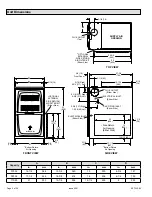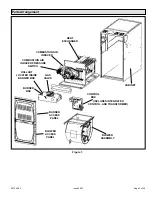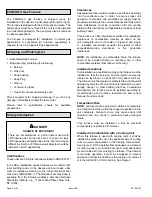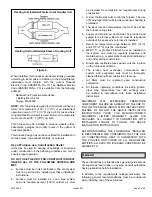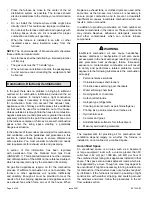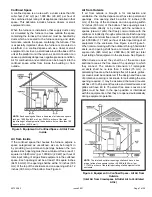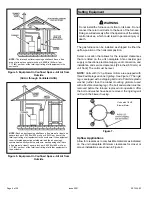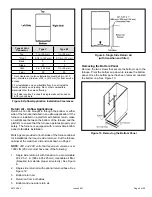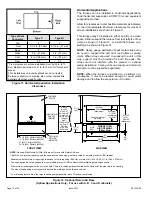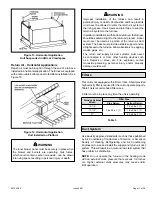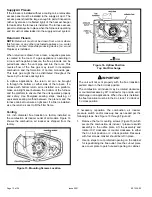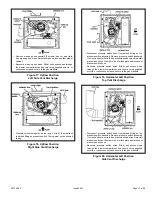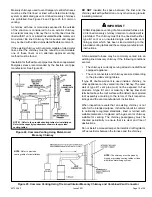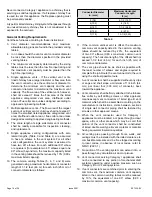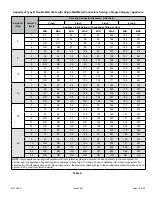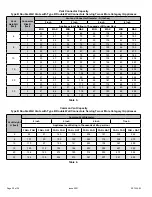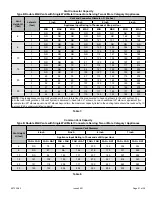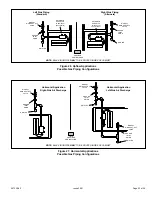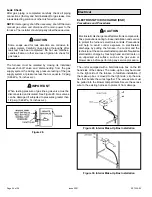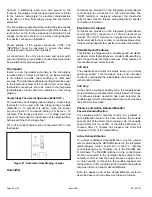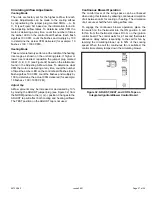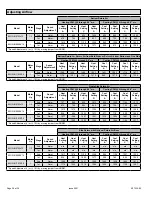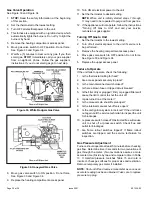
507335-02
Page 16 of 39
Issue 2001
Never connect a Category I appliance to a chimney that is
servicing a solid fuel appliance. If a fireplace chimney flue
is used to vent this appliance, the fireplace opening must
be permanently sealed.
A type B or listed chimney lining system that passes through
an unused masonry chimney flue is not considered to be
exposed to the outdoors.
General Venting Requirements
Vent these furnaces according to these instructions:
3. Vent diameter recommendations and maximum
allowable piping runs are found in the provided venting
tables.
4. In no case should the vent or vent connector diameter
be less than the diameter specified in the provided
venting tables.
5. The minimum vent capacity determined by the sizing
tables must be less than the low fire input rating and
the maximum vent capacity must be greater than the
high fire input rating.
6. Single appliance vents - If the vertical vent or tile
lined chimney has a larger diameter or flow area than
the vent connector, use the vertical vent diameter to
determine the minimum vent capacity and the vent
connector diameter to determine the maximum vent
capacity. The flow area of the vertical vent, however,
shall not exceed 7 times the flow area of the listed
appliance categorized vent area, drafthood outlet
area or flue collar area unless designed according to
approved engineering methods.
7. Multiple appliance vents - The flow area of the largest
section of vertical vent or chimney shall not exceed 7
times the smallest listed appliance categorized vent
area, drafthood outlet area or flue collar area unless
designed according to approved engineering methods.
8. The entire length of single wall metal vent connector
shall be readily accessible for inspection, cleaning,
and replacement.
9. Single appliance venting configurations with zero
lateral lengths (Table 3 and Table 4) are assumed
to have no elbows in the vent system. For all other
vent configurations, the vent system is assumed to
have two 90° elbows. For each additional 90° elbow
or equivalent (for example two 45° elbows equal one
90° elbow) beyond two, the maximum capacity listed
in the venting table should be reduced by 10% (0.90 x
maximum listed capacity).
10. The common venting Tables (5, 6, 7, and 8) were
generated using a maximum horizontal vent connector
length of 1-1/2 feet (.46 m) for each inch (25 mm) of
connector diameter as follows:
Table 2.
Connector Diameter
in. (mm)
Maximum Horizontal
Connector Length
ft. (m)
3 (76)
4-1/2 (1.37)
4 (102)
6 (1.83)
5 (127)
7-1/2 (2.29)
6 (152)
9 (2.74)
7 (178)
10-1/2 (3.20)
11. If the common vertical vent is offset, the maximum
common vent capacity listed in the common venting
tables should be reduced by 20%, the equivalent
of two 90° elbows (0.80 x maximum common vent
capacity). The horizontal length of the offset shall not
exceed 1-1/2 feet (.46 m) for each inch (25 mm) of
common vent diameter.
12. The vent pipe should be as short as possible with
the least number of elbows and angles required to
complete the job. Route the vent connector to the vent
using the shortest possible route.
13. A vent connector shall be supported without any dips
or sags and shall slope a minimum of 1/4 inch (6.4
mm) per linear foot (305 mm) of connector, back
toward the appliance.
14. Vent connectors shall be firmly attached to the furnace
flue collar by self drilling screws or other approved
means,except vent connectors of listed type B vent
material which shall be assembled according to the
manufacturer’s instructions. Joints between sections
of single wall connector piping shall be fastened by
screws or other approved means.
15. When the vent connector used for Category I
appliances must be located in or pass through a crawl
space, attic or other areas which may be cold, that
portion of the vent connector shall be constructed
of listed double wall type B vent material or material
having equivalent insulation qualities.
16. All venting pipe passing through floors, walls, and
ceilings must be installed with the listed clearance to
combustible materials and be fire stopped according
to local codes. In absence of local codes, refer to
NFGC (2223.1 ).
17. No portion of the venting system can extend into, or
pass through any circulation air duct or plenum.
18. Vent connectors serving Category I appliances shall
not be connected to any portion of mechanical draft
systems operating under positive pressure such as
Category III or IV venting systems.
19. If vent connectors are combined prior to entering the
common vent, the maximum common vent capacity
listed in the common venting tables must be reduced
by 10%, the equivalent of one 90° elbow (0.90 x
maximum common vent capacity).

